
Early Detection Support for Troops During COVID-19

Lt. Cmdr. Danett Bishop, from Hawthorn Woods, Illinois, tests respiratory samples in the biological safety lab of amphibious assault ship USS America (LHA 6). (U.S. Navy photo by Mass Communication Specialist Seaman Jonathan Berlier)
The quick spread of Coronavirus Disease 2019 has caused many health organizations including the Defense Health Agency’s Armed Forces Health Surveillance Division to innovate, using resources readily available in their arsenal.
One example of this innovation lies within AFHSD’s Global Emerging Infections Surveillance (GEIS) program. The team funded the production of Research Use Only testing kits and sent them to GEIS laboratory partners located across the globe; targeting countries with high totals of positive COVID-19 cases. Navy mobile laboratories embedded on military ships, such as the USS Theodore Roosevelt received these kits. Military commanders then used the kits as respiratory surveillance tools on their sailors and Marines.
The Department of Defense funds the GEIS’s network of 16 medical research laboratories. This funding allowed the teams to quickly reach out to their partners and use their capabilities, such as the quick production of research assays, to support our forces. Assays are an investigative procedure in laboratory medicine that assess or measure the presence, amount, or activity of a military-relevant pathogen—in this case, the current coronavirus. This assay is similar to those created by the U.S. Centers for Disease Control and Prevention.
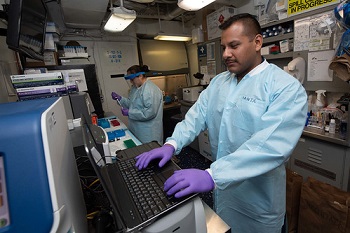
Hospital Corpsman 1st Class Ernesto Santa Ana, right, and Hospital Corpsman 2nd Class Maria F. Potts-Szoke work in Naval Medical Research Center's mobile laboratory aboard USS Theodore Roosevelt (CVN 71). (U.S. Navy/MCSN Kaylianna Genier)
“By rapidly distributing the RUO assays to our global partners and to three Navy mobile laboratories on shipboard settings, we were able to provide a much needed testing capability for this emerging pathogen in an operational environment,” explained U.S. Public Health Service Cmdr. (Dr.) Mark Scheckelhoff, who leads the respiratory infections focus area for GEIS. This assay supports surveillance studies only and not the clinical management of cases.
“The ability to procure and distribute the CDC RUO assay outside of a clinical laboratory setting provided a rapid and reliable source of COVID-19 testing and detection materials that were distributed to all of our network laboratories and allowed rapid implementation of testing activities,” said Scheckelhoff.
“As the COVID-19 cases began to increase around the world, military commanders in an operational environment had these RUO resources to conduct respiratory surveillance for COVID-19 exposure,” said Sean Friendly, chief of administration & operations at the AFHSD.
One recent example involved the Marine Corps Recruit Depot at Parris Island in South Carolina.
"Our partner, the Naval Health Research Center laboratory was able to use their surveillance capabilities to provide the assistance to detect the first cases,” said Friendly. He recounts a report from Dr. Chris Myers at NHRC in San Diego, California; the lab collected samples from the recruit population of Parris Island. GEIS-funded respiratory surveillance projects at NHRC provided the capability and personnel to test the recruits and quickly identify COVID-19.
GEIS has worked with the NHRC for several years and supported ongoing surveillance of respiratory diseases among recruits and trainees. This network of health partners continues to grow and evolve as GEIS coordinates with NHRC as well as other network partners. The network’s ability to integrate the priorities identified by the Combatant Commands into its mission creates an agile organization ready to respond to needs as they occur.
Since 1997, GEIS has funded key laboratory/epidemiological work across the DoD. It has also coordinated crucial infectious disease surveillance projects that could impact military operations. GEIS uses key DoD medical research laboratories—such as the U.S. Army Medical Research Institute for Infectious Diseases, the Navy Medical Research Center, and the Walter Reed Army Institute of Research’s global lab enterprise in Maryland; and the Air Force School of Aerospace Medicine in Dayton, Ohio — to establish an integrated network that studies the impact of infectious diseases and respond to outbreaks and epidemics.
“In lay terms, GEIS’s projects and activities have allowed DoD to maintain world-wide critical surveillance capabilities that continue to provide crucial support during events of public health concern like the COVID-19 pandemic,” stated Navy Capt. Guillermo Pimentel, GEIS chief.
Medical lab workers ensure readiness and wellness behind the scenes
Article
4/24/2020

This week, thank a medical laboratory professional
I Am Navy Medicine - Stopping the spread of COVID-19: Hospital Corpsman 3rd Class Donald Cooney
Article
4/23/2020
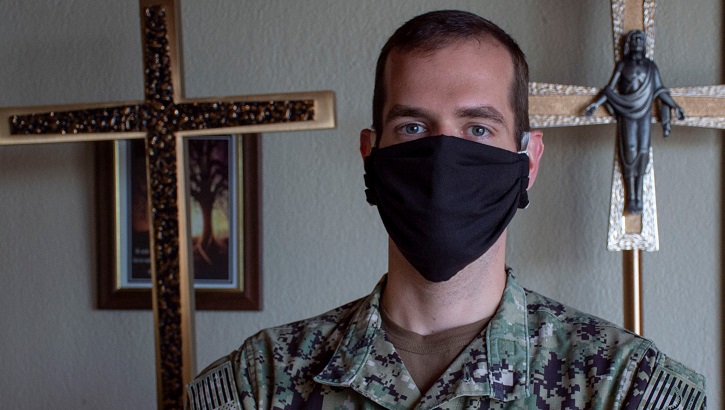
Faith and a strong sense to serve his country has brought a Lebanon, Ore., native to the world of Navy Medicine.
MHS - Defending the Homeland: Proning made easy at Keesler Air Force Base
Article
4/22/2020

Departments work together on solution to ICU breathing problem
DOD, VA launch Joint Health Information Exchange
Article
4/21/2020

Increased access leads to gains in patient care, outcomes
Cybersecurity critical for DoD teleworkers during pandemic
Article
4/21/2020
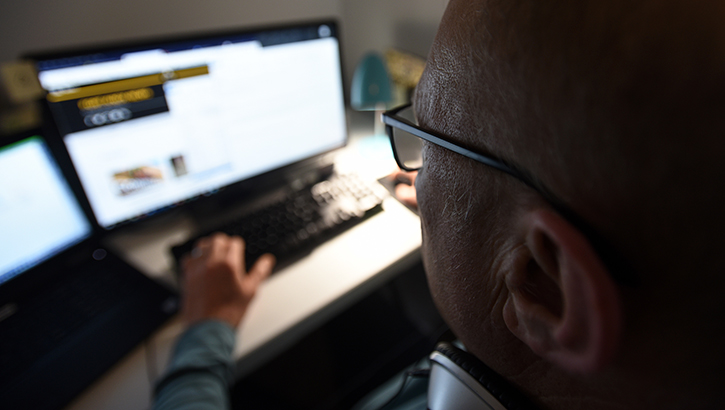
During the COVID-19 pandemic, there is a high-volume of DoD network users teleworking. Everyone must balance the requirements of the military health care mission with that of protecting the network, computers and mobile devices.
Modification and Reissuance of DoD Response to Coronavirus Disease 2019 -Travel Restrictions
Publication
4/20/2020
All DoD Service members will stop movement, both internationally and domestically, while this memorandum is in effect. All DoD civilian personnel, and dependents of DoD Service members and DoD civilian personnel, whose travel is Government-funded will stop movement, both internationally and domestically, while this memorandum is in effect.
Chaplains virtually bolster resiliency in the midst of COVID-19
Article
4/20/2020
.ashx?h=68&la=en&mw=120&w=120&hash=DDBD2352E890EA169BE8C49C79DDE1D1E15716AD350448EFD94B3077B60147CA)
The pandemic has charged the team to strengthen the bonds of interaction between itself and the community.
Coronavirus Disease 2019 (COVID-19) Surveillance Summary #13
Report
4/17/2020
AFMES missions continue through COVID-19
Article
4/17/2020
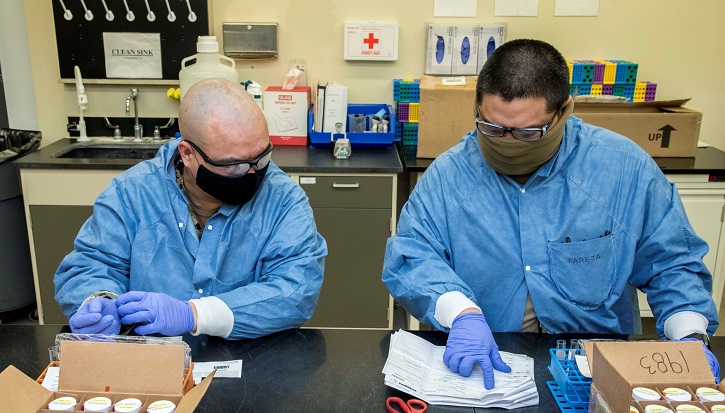
AFMES is a resilient organization that is committed to accomplishing the mission during the global pandemic.
Uniformed Services University Adds COVID 19 Training to Curriculum
Article
4/16/2020
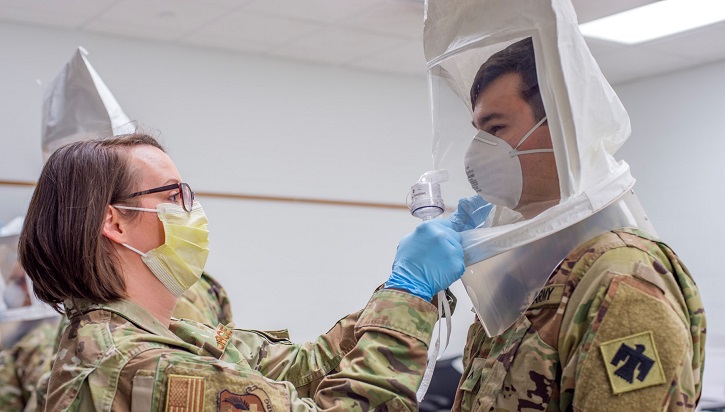
All of the university’s medical school Class of 2020 students completed the training prior to graduating, and the rest of the medical students have until April 15 to finish.
Mobile app may offer hope in times of distress
Article
4/16/2020
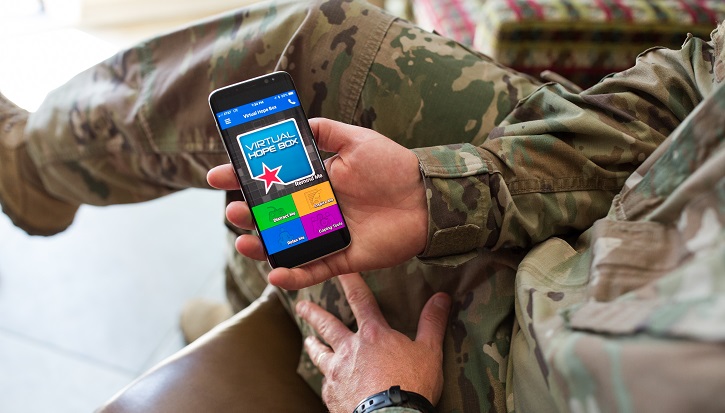
Virtual Hope Box is one mobile app solution that may help individuals cope
COVID-19 and its impact on healthcare in Europe
Article
4/15/2020
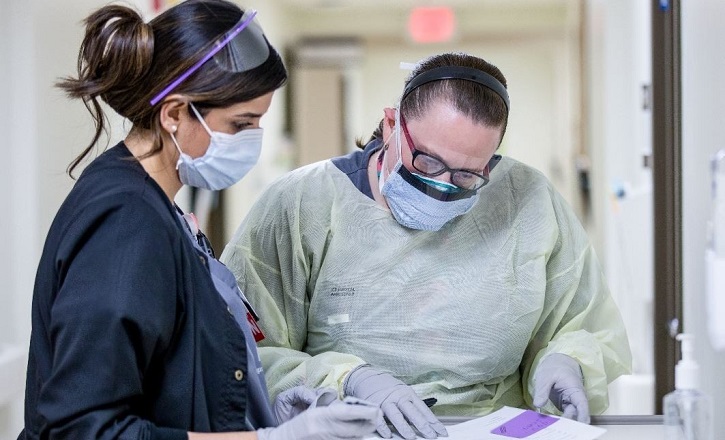
MTF staffs are working hard to meet the needs of beneficiaries across Europe
Memorandum on Providing Federal Support for Governors' Use of the National Guard to Respond to COVID-19
Publication
4/14/2020
Benefits Eligibility for 32 USC 502(f) Missions
Publication
4/14/2020
A chart outlining the various Benefits Eligibility for 32 USC 502(f) Missions
Implementation Guidance for Presidential Memorandum, "Providing Federal Support for Governor's Use of the National Guard to Respond to COVID-19 ," Dated April 7, 2020
Publication
4/14/2020






















.png)











No hay comentarios:
Publicar un comentario